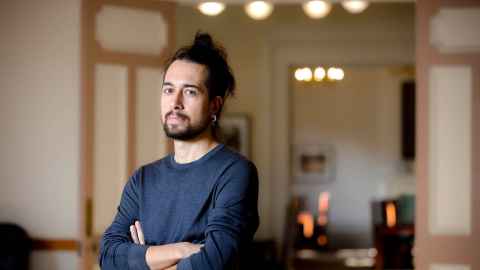New soundscape for General Library
1 July 2024
The first wholly sound-based artwork has joined the University of Auckland Art Collection.

Visitors recently filing in and out of the General Library may have heard music gently jangling in the air.
What they might be less aware of is that the music is tuning them into the rhythms of the cosmos.
Karanga is a soundscape installed at the library entrance as part of a wider project to revitalise the General Library area; a second University of Auckland Art Collection project, called Kaumoana, includes an interior waka installation and exterior anchor stone sculpture at the rear of the library facing Princes Street.
The first wholly sound-based artwork commissioned for the University of Auckland Art Collection, Karanga was created by Dr Fabio Morreale – a computer scientist and now senior lecturer in the School of Music.
Fabio was approached to create the work after composing other soundscapes, both as standalone works and to accompany other artworks, such as The Drawing Room by Aaron Paterson, Sarosh Mulla and Marian Macken exhibited at CoCa – the Centre of Contemporary Art Toi Moroki in Christchurch.
He says he was given a relatively open brief to create the General Library work and, as a specialist in the technology used to create electronic music, he had seemingly limitless possibilities.
“I was interested in experimenting; in a creative quest to explore ontological questions like ‘what is music?’ and how you can arrive at new experiences of musical enjoyment, even if it’s not necessarily music that sounds good.”
Still, he needed parameters. He wanted the work to constantly change, so to create ‘rules’ governing that change he looked to the universe, creating an electronic composition of sounds aligned with the changing tides, lunar phases, Earth’s rotation, and the distance between the Earth and Sun.
I was interested in experimenting; in a creative quest to
explore ontological questions like ‘what is music?’
He also wanted the work to be interactive, so the composition changes as people, captured by CCTV, walk in and out of the space – an interaction reflected in the work’s title, referencing the call and response of a karanga.
Fabio’s academic research probes areas such as human-computer interaction and the ethics of AI, and he says that while the CCTV doesn’t record people, it introduces an element of social commentary to the artwork.
“I wanted to create a kind of surveillance art to take a critical, political stance; to highlight these controversial technologies, and for people to reflect on these, as we’re not really aware of where they are and how they function.”
There were also practical considerations. One of the biggest, he says, was that the music sounded pleasant and played at a respectful volume for those using the space, particularly library staff.
Another was that the composition was intriguing enough to attract listeners’ attention, but not so much that they would linger and clog up the entranceway.
He initially thought of creating more ambient, drone-like sounds for the work, but he ultimately hit upon the sounds used in Karanga through experimentation. He describes it as “a cascade of string sounds that don’t ever have a tonal centre”.
Fabio has a background as a musician, albeit in an extremely narrow niche. He was an accomplished brutal death-metal guitarist, but the highly technical and physical nature of the playing required up to six hours of daily practice and ultimately led him to give it up when he was doing his PhD.
Music was a theme in his computer science studies in Italy, and later the UK; his PhD explored using computational power, techniques and algorithms to compose music and he became fascinated with human-computer interaction, particularly related to new music technologies.
When looking to move to New Zealand with his Kiwi wife, he applied for a position teaching electronic music composition at the School of Music in 2019 and this year became an associate dean of postgraduate research in the Faculty of Creative Arts and Industries.
Fabio’s research is focused on traditional, written academic output rather than creative composition, and he sees Karanga more in terms of its hardware and software – its speakers, algorithms and sensors – than as a musical work in its own right. The plan is to invite composers from around the world to undertake a short residency to create compositions to play on Karanga, and these, along with compositions created by postgraduate students, will play in a loop through the work.
“I see it as an instrument that, at the moment, has only one piece that was written for it, which is my piece. But as we go on, there are going to be more.”
Caitlin Sykes
This story first appeared in the July 2024 issue of UniNews.